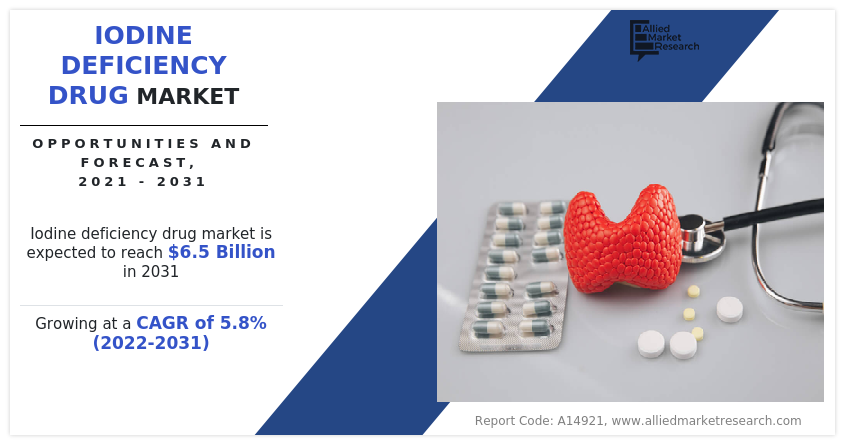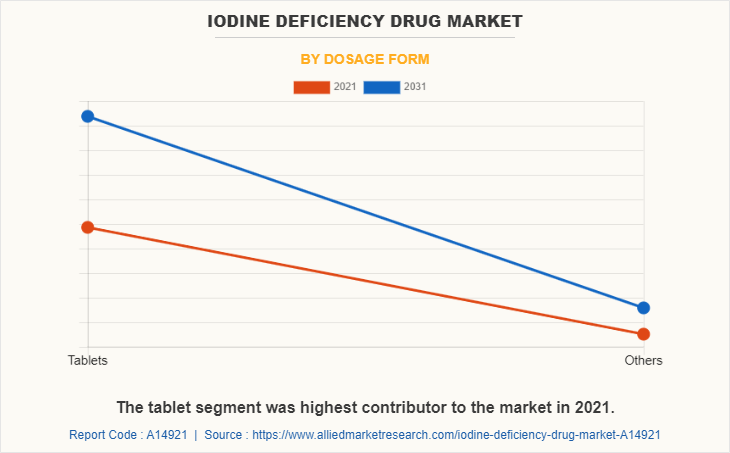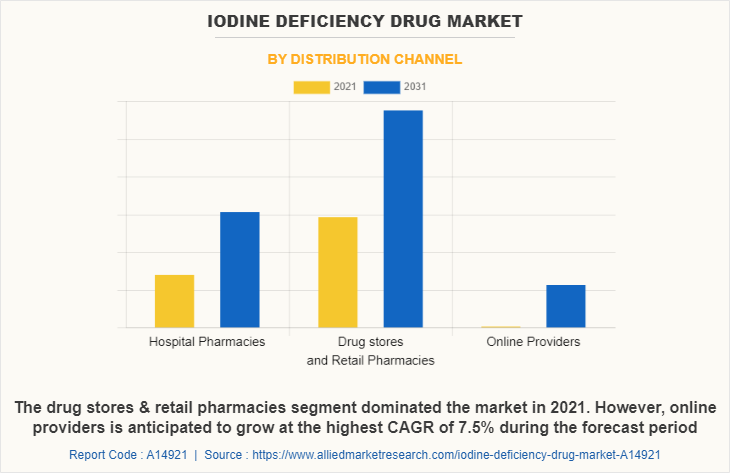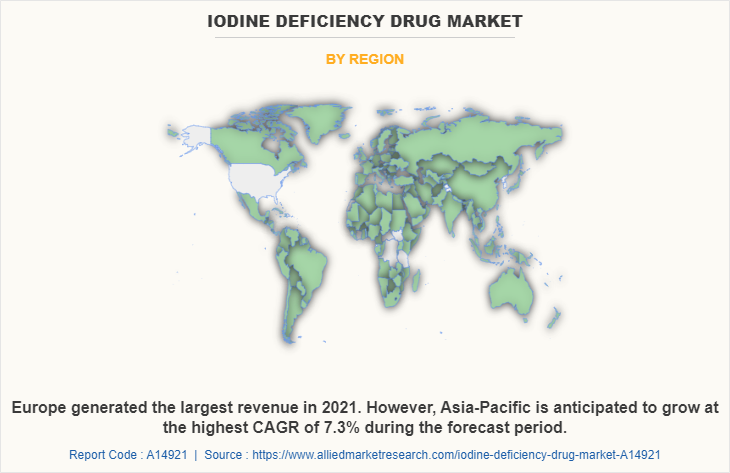Iodine Deficiency Drug Market Research, 2031
The global iodine deficiency drug market size was valued at $3.7 billion in 2021, and is projected to reach $6.5 billion by 2031, growing at a CAGR of 5.8% from 2022 to 2031. Iodine Deficiency Disorders (IDD) are one of the biggest worldwide public health issue. An inadequate dietary intake of iodine leads to insufficient production of thyroid hormones. Inadequate hormone production adversely affects tissues, resulting in the disease states known collectively as iodine deficiency disorders, or IDD. Severe and prolonged iodine deficiency may lead to a deficient supply of thyroid hormones. This condition is referred to as hypothyroidism.
Hypothyroidism can affect people of all ages, genders and ethnicities. It’s a common condition, particularly among women over age 60. Women are generally more likely to develop hypothyroidism after menopause than earlier in life. In addition, hypothyroidism is commonly seen in children in many countries. For instance, according to an article published in National Library of Medicine 2021, in Oman showed 10% school children of 9–12 years age, signs of hypothyroidism and 88.1% of the children did not show any symptoms.

The drivers for iodine deficiency drug market size are increase in prevalence of hypothyroidism in geriatric populations, increase in hypothyroidism in children of 9-15 years of age, education of iodine deficiency disorders across the globe and various healthcare plans by organizations for deficiency disorders.
The increase in cases of geriatric hypothyroidism is seen all over the world due to age and less production of thyroid hormones. Thus, this factor drives the growth of the iodine deficiency drug market as many developing regions have significant older population. For instance, according to article published in Journal of Endocrine Society 2019, 3 – 3.5% population of Europe suffers from hypothyroidism as compared to general population which is 0.2 – 5%.
Every year many education programs and camps are organized to educate people about iodine deficiency disorders, especially across the developing regions. For instance, according American Thyroid Association 2021, every year January month is celebrated as thyroid awareness month to educate people about hypothyroidism and deficiency disorders across the globe.
In addition, many hospitals and research institute in India educate people regarding iodine deficiency. For instance, Kokilaben Dhirubhai Ambani Hospital & Medical Research Institute, every year in January, education about hypothyroidism is carried for people through qualified physicians and endocrine researchers. These education programs across the globe fuel the iodine deficiency drug market growth.
Further, increase in hypothyroidism in children of 9-15 years of age in many developing countries is seen, which leads to demand in iodine deficiency drugs. For instance, according to research article in Pediatric Research 2022, incidence of congenital hypothyroidism in Finland is 3.6% due to which they are monitored with proper dosage forms to prevent further growth & development problems in children. So due to surge in demand for drugs for treating hypothyroidism is noted, which boost the market growth.
The pharmaceutical company are focusing on this sector and are receiving approvals to meet the demand of levothyroxine drugs in countries where healthcare facility is undeveloped. For instance, Zydus Cadila in 2021 received the U.S. FDA approval for thyroid drug for hypothyroidism. Thus, various drug launches and research in this field boost the growth of iodine deficiency drug market.
On the other hand, side effects associated with levothyroxine drug used for hypothyroidism hinders the growth during iodine deficiency drug market forecast. The major side effect associated with levothyroxine is increased or irregular palpitations. In addition, physicians suggest regular blood tests to monitor levels of iodine in pregnancy, for heart patients which might limit the population or hinder the growth of this market.
The pharmaceutical players showed keen interest in developing regions and countries with high iodine deficiency disorders for manufacturing and commercializing various levothyroxine drug for treatment of disorders. Thus, companies are focusing on iodine deficiency drug market opportunity in developing countries.
Impact of COVID-19 on the Market
The outbreak of COVID-19 has disrupted workflows in the health care sector across the world. The disease has forced a number of industries to shut their doors temporarily, including several sub-domains of health care. However, COVID-19 pandemic positively impacted the iodine deficiency drug industry. There was surge in demand of thyroxin drugs required to treat iodine deficiency disorders. During pandemic, increase in cases of thyroid disease showed rise in geriatric population, congenital hypothyroidisms and pregnancy hypothyroidism. For instance, according to an article published in National Library of Medicine 2020, increase in cases of hypothyroidism during COVID-19 was observed i.e., 5.2% cases observed. Also, during pandemic, many drug formulations were approved in regions such as Asia-Pacific and Europe. Thus, COVID-19 pandemic showed positive impact on iodine deficiency drug industry.
IODINE DEFICIENCY DRUG MARKET SEGMENTATION
The global iodine deficiency drug market is segmented on the basis of dosage form, distribution channel, and region. On the basis of dosage form, it is segmented into tablets and others (softgel capsules, liquid formulations & injections). On the basis of distribution channel, it is segmented into Hospital pharmacies, Drug stores & retail pharmacies, and online providers. Region wise, the market is analyzed across North America, Europe, Asia-Pacific, and LAMEA.
By dosage form, tablet segment generate largest iodine deficiency drug market share in 2021, and is expected to continue this trend throughout the forecast period, as its cost is minimum, suitable for wider population in developing region.

By distribution channel, the drug stores & retail pharmacies segment dominated the market in 2021, and is expected to remain dominant during the forecast period, due to rise in demand for iodine deficiency disorders and increased use of drugs for treatment of hypothyroidism by people in developing regions.

The Europe market dominated iodine deficiency drug market share in 2021, due to increase in consumer spending in healthcare sector and rise in cases of hypothyroidism in the region.

Some of the major companies that operate in the global iodine deficiency drug market are Abbott Laboratories, AbbVie Inc, Cipla Ltd, Fresenius SE & Co. KGaA (Fresenius Kabi), GlasxoSmithKline, Lupin, Macleods Pharmaceuticals, Merck KGaA, Pfizer, and Teva Pharmaceutical Industries Ltd, Inc.
Key Benefits For Stakeholders
- This report provides a quantitative analysis of the market segments, current trends, estimations, and dynamics of the iodine deficiency drug market analysis from 2021 to 2031 to identify the prevailing iodine deficiency drug market opportunities.
- The market research is offered along with information related to key drivers, restraints, and opportunities.
- Porter's five forces analysis highlights the potency of buyers and suppliers to enable stakeholders make profit-oriented business decisions and strengthen their supplier-buyer network.
- In-depth analysis of the iodine deficiency drug market segmentation assists to determine the prevailing market opportunities.
- Major countries in each region are mapped according to their revenue contribution to the global market.
- Market player positioning facilitates benchmarking and provides a clear understanding of the present position of the market players.
- The report includes the analysis of the regional as well as global iodine deficiency drug market trends, key players, market segments, application areas, and market growth strategies.
Iodine Deficiency Drug Market Report Highlights
| Aspects | Details |
| Market Size By 2031 | USD 6.5 billion |
| Growth Rate | CAGR of 5.8% |
| Forecast period | 2021 - 2031 |
| Report Pages | 199 |
| By Distribution Channel |
|
| By Dosage Form |
|
| By Region |
|
| Key Market Players | Abbvie Inc, Abbott Laboratories, Cipla Ltd, Fresenius SE and Co. KGaA, Lupin Ltd, Pfizer Inc., Merck KGaA, Macleods Pharmaceuticals Ltd, Teva Pharmaceutical Industries Ltd., Glaxosmithkline plc |
Analyst Review
Increase in iodine deficiency across developing countries is noted. The Hypothyroidism is main cause of iodine deficiency. In addition, insufficient iodine during pregnancy and infancy results in neurological and psychological deficits in children. Thus, for treating hypothyroidism disorder, various programs like Universal salt iodization are organized by World Health Organization.
Increase in hypothyroidism or goiter cases due to iodine deficiency across globe has largely contributed in the iodine deficiency drug market revenue in 2021, and is expected to maintain this trend throughout the forecast period. Also, increase in iodine deficiency in neonatal in various regions and awareness regarding iodine deficiency disorders boost the market. To meet the global supply of levothyroxine, pharmaceutical manufacturers are increasing production and developing new formulations to aid wider population which significantly contributes towards the revenue generation.
Furthermore, Europe is expected to witness highest growth, in terms of revenue, owing to increase in awareness towards iodine deficiency disorders and rise in government initiatives promoting iodine salt consumption drive the market growth. However, Asia-Pacific is anticipated to witness notable growth, owing to increase in investments for manufacturing iodine deficiency drug during the forecast period. In addition, upsurge in healthcare expenditure in the emerging economies is anticipated to offer lucrative opportunities for the market expansion.
The market value of iodine deficiency treatment market in 2031 is $6470.39 million
Top companies such as, Lupin, Fresenius SE & Co. KGaA (Fresenius Kabi) and Macleods Pharmaceuticals held a high market position in 2020. These key players held a high market postion owing to the strong geographical foothold in different regions.
Tablets is the most influencing segment in iodine deficiency treatment market which is attributed to rise in demand for tablet dosage form owing to economic and patient compliance for iodine deficiency treatment.
The base year is 2021 in iodine deficiency treatment market.
Iodine deficiency treatments are the medications used to treat iodine deficiency disorders like hypothyrodisim and goiter.
The major factor that fuels the growth of the iodine deficiency treatment market are increase in prevalence of iodine deficiency, rise in demand for advanced and effective treatment, and increase in healthcare spending.
The forecast period for iodine deficiency treatment market is 2022 to 2031
The total market value of iodine deficiency treatment market is $3674.65 million in 2021.
Loading Table Of Content...



